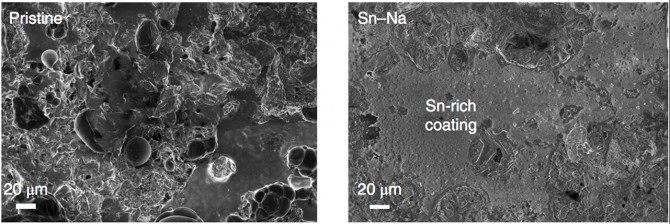Next-generation rechargeable battery made with tin
By Syl Kapacyr
The development of next-generation rechargeable batteries that store more energy and last longer has been stifled by an electrochemical challenge. Cornell engineers have come up with a simple, but clever solution to the problem.
Lithium-ion batteries, like those used in cellphones and electric vehicles, are limited in their electric-charge capacity because of their graphite anodes. Researchers have sought anodes made from alkali metals such as lithium and sodium because they allow for greater capacity, but alkali metals are highly reactive with traditional battery electrolytes. This can lead to the formation of dendrites – pointy metallic structures that make the battery susceptible to a shorter lifetime and potentially dangerous short-circuiting.
A team of engineers working in the lab of Lynden Archer, professor of chemical and biomolecular engineering and director of the Cornell Energy Systems Institute, has demonstrated a cost-effective way to stabilize lithium and sodium anodes using tin as a protective interface between the anode and the battery’s electrolytes.
The research is detailed in the paper “Fast ion transport at solid-solid interfaces in hybrid battery anodes” published March 5 in Nature Energy.
By dropping tin into a battery’s carbonate-based electrolyte, the research team found that an artificial interface instantly forms on the alkali-metal anode, creating a nanometer-thick barrier that protects the anode like a shield while keeping it electrochemically active. Cryo-microscopy performed in the lab of Lena Kourkoutis, assistant professor of applied and engineering physics, revealed that the technique produced dendrite-free batteries.
Zhengyuan Tu, a doctoral student who led the research, said the interface offers several advantages beyond simply stabilizing the battery.
“The target was to find a facile process to not only protect the pristine anodes, but to also be able to store additional energy,” said Tu. “Tin and other elements have long been exciting candidates for energy storage by readily forming alloys with lithium, so this led us to the concept that a tin interface on lithium would not only offer protection, but added electrochemical activity.”
And unlike other artificial interface materials, tin is easier to apply during the manufacturing process because it requiresa minimal amount of specialized equipment and processing, according to Tu.
Testing of the tin interface on a lithium anode revealed a battery life cycle of more than 500 hours at a current density of 3 milliamperes per square centimeter. The test was repeated without the protective interface and the battery lasted just 55 hours.
The research team reported that the source of the improvements was the ability of lithium to rapidly alloy with tin, which facilitated more uniform lithium deposition when the anode was recharged. Dendrite-free performance was observed in a variety of other experiments, including the use of a high-loading cathode material with the battery. The tin interface was also evaluated using a sodium anode, notorious for its high reactivity and propensity to form dendrites. An enhancement in lifetime from less than 10 hours to more than 1,700 hours was observed at moderate current density.
“Lots of efforts have been devoted to developing sodium-ion batteries because sodium is cheaper than lithium,” said Tu. “Although sodium-related battery technology is still in the early stage, it is a part of the metal-based battery family and is recognized to be promising.”
The research team plans to examine their hybrid anode concept to understand the design rules for using electrochemically active metals as artificial interfaces for high-energy alkali metal anodes. They have also begun efforts to optimize their anode design to facilitate larger-scale deployment.
The research was supported by the U.S. Department of Energy’s Advanced Research Projects Agency – Energy and by the National Science Foundation.
Syl Kacapyr is public relations and content manager for the College of Engineering.
Media Contact
Get Cornell news delivered right to your inbox.
Subscribe

